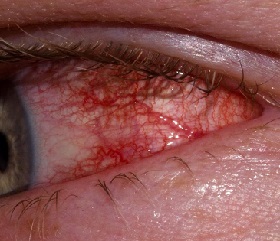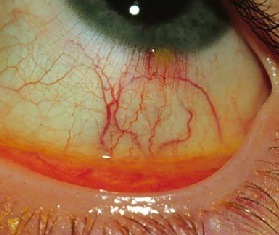 Conjunctivitis is one of the most common eye diseases. It is difficult to find a person who at least once in his life would not have the characteristic symptoms: redness and irritation of the eye, tear ...
Conjunctivitis is one of the most common eye diseases. It is difficult to find a person who at least once in his life would not have the characteristic symptoms: redness and irritation of the eye, tear ...
Therefore, there is an opinion that conjunctivitis is not a serious disease, well, reddening the eye, combing it - tomorrow it will pass... It's not! To treat conjunctivitis necessarily, seriously and skillfully.
In most cases, the disease is caused by a bacterial and viral infection, an allergic reaction, but there are other factors.
Classification
Depending on the cause, causing the disease, conjunctivitis occurs:
- Bacterial- Streptococcus, pneumococcus, staphylococcus, gonococcus, chlamydia and diphtheria are more common;
- Viral- always accompanied by catarrhal diseases that were caused by adenoviruses. Also, conjunctivitis caused by the herpes virus is often observed;
- Allergic- occurs in response to the action of the allergen (dust, wool, pollen, etc.), can also accompany hay fever, allergic rhinitis, bronchial asthma, etc .;
- Other types- arise on the action of chemical substances (chemical reagents, varnishes, paints, industrial vapors, etc.).
Depending on which pathogen caused conjunctivitis, the symptoms and methods of treatment will vary.
Symptoms of conjunctivitis
The main signs of conjunctivitis are:
- redness of the conjunctiva of the eye;
- burning and irritation;
- detachable tissues mucopurulent;
- sticky eyelids (especially after sleep);
- eyelids edematous and crusted.
In general, conjunctivitis is manifested by the edema of eyelids and conjunctiva, redness of the eye protein, photophobia, lacrimation. A number of symptoms may indicate the cause that caused the development of the disease.
Symptoms of conjunctivitis
With conjunctivitis, the symptoms will depend on the form of the disease.
- Acute- begins suddenly with pain or relief, first on one, then on the other eye. Against the background of pronounced reddening, spot hemorrhages are often observed. Appears mucous, mucopurulent or purulent discharge. This form can be accompanied by general malaise, fever and headache. Its duration ranges from 5-6 days to 2-3 weeks.
- Chronic formaccompanied by a sensation of burning, itching, sand in the eyes, rapid fatigue of the organ of vision.
- If it is calledbacterial infection, then there are crusts on the eyelids and abundant detachable from the eyes, which from time to time can acquire a greenish tinge. The inflammatory process can spread to both eyes.
- In the case of viral conjunctivitis, it is likely that puffiness and denseness of the eyelids, tearing of the eyes with a small amount of discharge will be observed. In many cases, the process has a one-way flow.
- If the cause isallergy, then it is accompanied by itching, reddening of the eyes and lacrimation. It is likely that along with this, nasal congestion and itching will be felt, there will be a discharge from the nasal passages.
- Toxic- are caused by toxic substances. In this form of the disease, irritation and pain in the eyes are felt, especially when the eyes move up or down. Itching and vydeleny usually do not.
- Blinocrenic- characterized by serous-bloody discharge, which after 3-4 days becomes purulent, sometimes corneal ulcers and infiltrates are formed.
- Kokha-Wicks conjunctivitisdevelops in the form of a large number of small hemorrhages in the conjunctiva, there is swelling, which looks like elevations within the eye gap that have the form of triangles.
there isgeneral symptomsconjunctivitis (see photo), which are not specific and are manifested in any pathogen: hyperemia and edema of the eyelids, itching, burning, photophobia, the presence separated from the eye gap (by its nature, we can assume the pathogen), the feeling of a foreign body after the century.
To quickly cure conjunctivitis, it is necessary to seek qualified help at the first signs of ailment.
Treatment of conjunctivitis
 In order to determine how to treat conjunctivitis, it is necessary to identify the underlying cause of the disease.
In order to determine how to treat conjunctivitis, it is necessary to identify the underlying cause of the disease.
To remove purulent contents, you should regularly wash eyeballs with 2% boric acid composition, as well as weak solutions of furacilin and potassium permanganate. Between the washes it is recommended that antiseptic eye drops drip into the cavity of the conjunctiva (Albucid 20%).
The main treatment for conjunctivitis is appointed by an ophthalmologist, it will depend on the cause of the disease.
- Whenbacterial conjunctivitisfor treatment, antibiotics are prescribed in the form of drops (0.25% solution of levomycetin, sodium sulfacyl). In the presence of an abundant discharge, the conjunctival sac is washed with solutions of furacilin (1: , 00), potassium permanganate (1: 5 000), and also put in it 1% oletetrinovuju ointment (2-3 times a day at a heavy current of process, 1 time - at lung).
- In the treatmentviral conjunctivitisprescribe human leukocyte interferon or interferonogens (pyrogenal, poludan) in the form of injections into the conjunctival bag 6-8 times a day, as well as 0.5% florenal, 0.05% bonaflone and other eye ointments.
- Whenchlamydial conjunctivitis, except for local treatment, systemic reception of doxycycline, tetracycline or erythromycin is shown.
- In the treatmentfungal conjunctivitislocally in the infusions, depending on the type of fungus, nystatin, levorin, amphotericin B and others are prescribed.
- Therapy of allergic conjunctivitis includes the appointment of vasoconstrictor and antihistamine drops, corticosteroids, lacrimony, the use of desensitizing drugs. With conjunctivitis of fungal etiology, antimycotic ointments and instillations (levorin, nystatin, amphotericin B, etc.) are prescribed.
- With the "dry eye" syndrome(occurs as a secondary post-infection lesion of either the tear apparatus, or goblet cells producing mucus, or defeat meibomia glands that prevent the evaporation of tears) - apply artificial tear preparations (Oxial).
The ophthalmologist will explain in more detail how to treat conjunctivitis at home based on his experience.
Drops with conjunctivitis
Eye drops from conjunctivitis are the main remedy for the treatment of eye diseases, including all types of conjunctivitis. To treat conjunctivitis, adults also use antibacterial drugs, this depends on the cause that caused the disease.
- Whenbacterial formuse such drops as Floxal, Ciprofloxacin, and others. To enhance the effect, you can put a tetracycline ointment on your eyelids. In most cases, the use of these drugs is enough to quickly cure conjunctivitis at home.
- Whenallergic natureused antihistamine drops (Opatanol, Lecrolin, etc.), as well as hormonal drops and ointments (Hydrocortisone ophthalmic ointment, Dexamethasone).
- If the cause of the disease isvirus- prescribe medications containing interferon (Ophthalmoferon, Poludan). Often the infection is mixed or the causative agent of the disease can not be accurately established during examination, in this case, a complex of drops is prescribed.
As already mentioned, the nature of the disease (viral, bacterial or allergic) can be established only by the doctor ophthalmologist at full-time examination.
Self-treatment with folk remedies can lead to the development of complications or the transition of the disease to a chronic form, as they are not able to cope with the infection.

How to choose probiotics for the intestine: a list of drugs.

Effective and inexpensive cough syrups for children and adults.

Modern non-steroidal anti-inflammatory drugs.

Review of tablets from the increased pressure of the new generation.
 Antiviral drugs are inexpensive and effective.
Antiviral drugs are inexpensive and effective.


